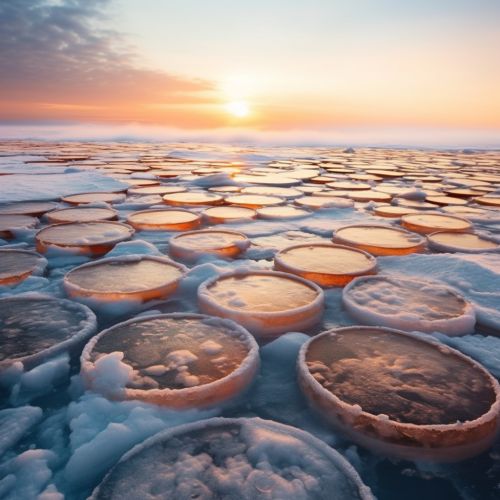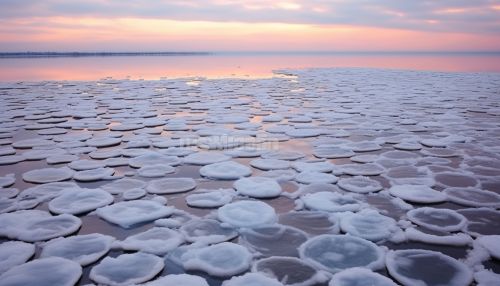Pancake ice
Introduction
Pancake ice is a type of sea ice characterized by its unique, round shape, reminiscent of a breakfast pancake. It is a stage in the evolution of sea ice that typically forms in turbulent waters, such as in the Southern Ocean or the Baltic Sea. The formation of pancake ice is a fascinating phenomenon that involves a combination of atmospheric, oceanic, and ice interactions.


Formation
The formation of pancake ice is a complex process that begins with the freezing of sea water. When the atmospheric temperature drops below the freezing point of sea water, which is slightly below 0°C due to the presence of salt, the water begins to freeze, forming a thin layer of ice on the surface. This initial stage of ice formation is known as grease ice due to its slick appearance.
As the wind and waves continue to act on the grease ice, it breaks up into smaller pieces. These pieces are then tossed around by the waves, causing them to collide with each other. The collisions round off the edges of the ice pieces, giving them their characteristic pancake shape. The constant churning of the water also causes the ice pieces to accumulate additional layers of ice, increasing their thickness.
Characteristics
Pancake ice pieces typically range in size from 30 cm to 3 m in diameter, with a thickness of 10 cm to 1 m. They are defined by their raised edges, which result from the ice pieces colliding and piling up on each other. The surface of pancake ice is usually rough due to the constant collisions and freezing of additional layers of ice.
One of the unique characteristics of pancake ice is its ability to form in a wide range of conditions. While it is most commonly observed in the open ocean, it can also form in more sheltered areas, such as in bays and inlets. It can even form in rivers and lakes if the conditions are right.
Impact on the Environment
Pancake ice plays a significant role in the cryosphere, the portion of Earth's surface where water is in solid form. It contributes to the overall extent of sea ice, which has a direct impact on the global climate system. Sea ice reflects sunlight back into space, helping to regulate the Earth's temperature. The formation of pancake ice, therefore, can have implications for climate change.
In addition to its role in the climate system, pancake ice also has an impact on marine ecosystems. It provides a habitat for a variety of organisms, from tiny plankton to larger animals like seals and polar bears. The underside of pancake ice is often home to a diverse community of ice algae, which forms the base of the marine food web.
Research and Study
The study of pancake ice is a significant area of research in the field of cryospheric science. Scientists use a variety of methods to study pancake ice, including satellite imagery, field observations, and computer models. These studies help to improve our understanding of the processes involved in the formation of pancake ice, as well as its impact on the environment and climate.
One of the challenges in studying pancake ice is the harsh conditions in which it forms. The Southern Ocean and the Baltic Sea, where pancake ice is commonly found, are known for their extreme weather and rough seas. However, advances in technology, such as the use of unmanned aerial vehicles (UAVs) and autonomous underwater vehicles (AUVs), are making it easier for scientists to study pancake ice in these challenging environments.
